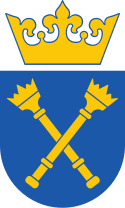Academy of Cracow
|
Uniwersytet Jagielloński
|
|
 |
|
| Latin: Universitas Iagellonica Cracoviensis | |
|
Former names
|
University of Kraków (1364–1817) |
|---|---|
| Motto | Plus ratio quam vis |
|
Motto in English
|
Let reason prevail over force |
| Type | Public |
| Established | 1364 (654 years ago) |
| Rector | Wojciech Nowak[] |
|
Academic staff
|
3,857 (2017) |
| Students | 43,405 (2017) |
| Undergraduates | 38,535 (2017) |
| Postgraduates | 1,655 (2017) |
| 3,215 (2017) | |
| Location |
Kraków, Poland Coordinates: 50°3′39″N 19°55′58″E / 50.06083°N 19.93278°E |
| Campus | Urban/College town |
| Affiliations | EUA, Coimbra Group, Europaeum, Utrecht Network, EAIE, IRUN |
| Website | www.uj.edu.pl |
| University rankings | |
|---|---|
| Global | |
| ARWU | 401–500 |
| QS | 431–440 |
| Times | 601–800 |
The Jagiellonian University (Polish: Uniwersytet Jagielloński; Latin: Universitas Iagellonica Cracoviensis, also known as the University of Kraków) is a research university in Kraków, Poland.
Founded in 1364 by Casimir III the Great, the Jagiellonian University is the oldest university in Poland, the second oldest university in Central Europe, and one of the oldest surviving universities in the world. Notable alumni include, among others, mathematician and astronomer Nicolaus Copernicus, poet Jan Kochanowski, Polish king John III Sobieski, constitutional reformer Hugo Kołłątaj, chemist Karol Olszewski, anthropologist Bronisław Malinowski, writer Stanisław Lem and the President of Poland Andrzej Duda. Among its students who didn't earn a diploma were also Karol Wojtyła, future Pope John Paul II (studying for one year Polish philology) and Nobel laureates Ivo Andrić and Wisława Szymborska.
The campus of the Jagiellonian University is centrally located within the city of Kraków. The university consists of fifteen faculties — including the humanities, law, the natural and social sciences, and medicine. The university employs roughly 4,000 academics, and has more than 40,000 students who study in some 80 disciplines. More than half of the student body are women. The language of instruction is usually Polish, although several degrees are offered in either German or English. The university library is one of Poland's largest, and houses several medieval manuscripts, including Copernicus' De Revolutionibus.
...
Wikipedia

